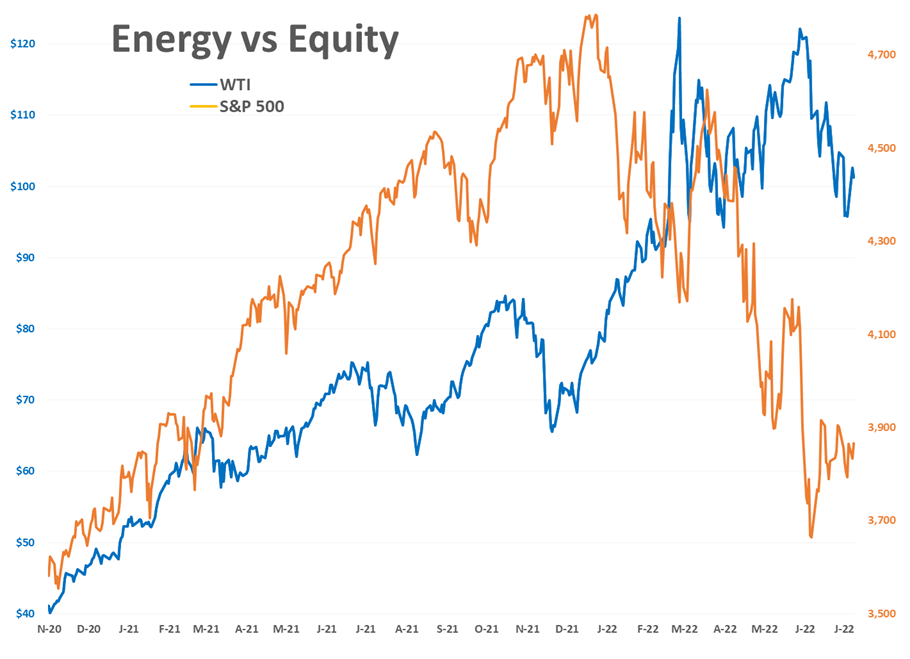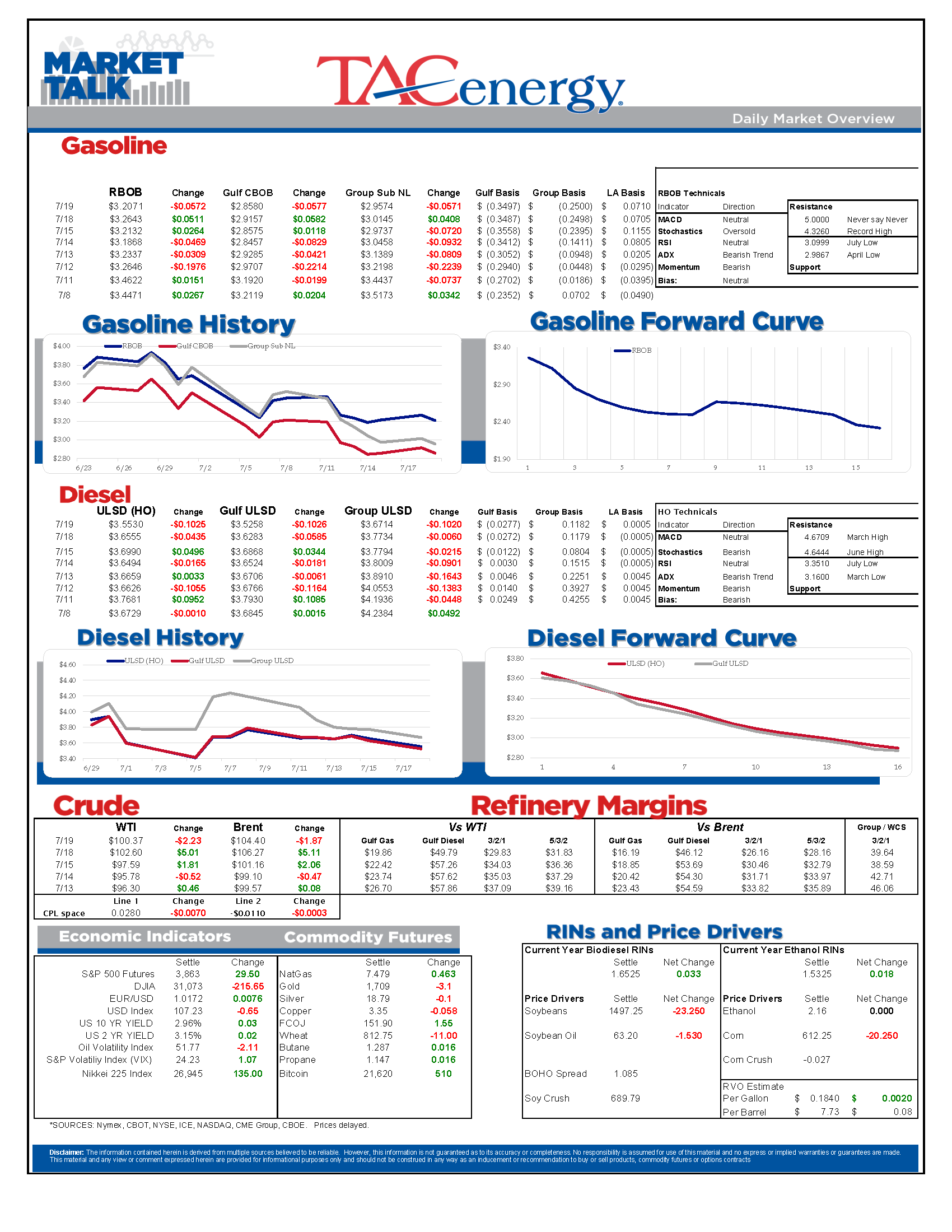Gasoline Prices Tried To Drag The Petroleum Complex Higher Monday And Diesel Prices Are Trying To Drag Them Lower Today

Gasoline prices tried to drag the petroleum complex higher Monday and Diesel prices are trying to drag them lower today. ULSD futures were down 14 cents at their low point this morning, pulling RBOB down a nickel – wiping out its gains from yesterday - and WTI briefly back below the $100 mark. Expect more of this back and forth action as long as prices remain stuck consolidating within the range set the past two weeks.
Force Majeure has become a theme this week around the world. Keystone pipeline declared Force Majeure after a nearby power substation was vandalized and forced the line to reduce operating rates. The relative lack of reaction in US crude markets suggests that this event is expected to be short-lived.
The last functioning refinery in South Africa meanwhile was forced to declare Force Majeure due to delays in crude oil deliveries, sparking fears in a country that’s already heavily reliant on imports of fuel which are much harder to come by this year.
Last, and certainly not least, much of Europe is nervously awaiting news on whether or not Russia will reopen the Nordstream natural gas pipeline in time to restock for the winter after Force Majeure was declared. Interestingly enough, Canada is playing a central role in the Nordstream drama as it exempted sanctions on Russia to allow repairs to a turbine that may allow the pipeline to come back online, and take away one of Russia’s excuses for turning off the gas.
Currency swings are also having a heavy influence in the price action for energy and other commodities recently, with the inverse correlation between the US Dollar and WTI prices strengthening in recent weeks after going dormant for a while. Expect that trend to continue at least through next week’s FOMC announcement, which is all but assured to see at least a 75 point rate increase. With the FED doing its best to telegraph its moves to try and avoid shocking the market into a recession as it shuts down the money printing presses, questions over the European Central Bank’s plans seem to be creating some volatility this week and getting some of the credit for the choppy action in commodity markets.
After disappointing results in trying to get more petroleum production from OPEC and US refiners, and a failure in the Senate to move forward on climate initiatives, the White House is reportedly considering declaring a climate emergency this week in an effort to thread the needle between lowering energy prices, and lowering energy emissions to appease voters ahead of the election. That said, the recent Supreme Court decision restricting the EPA’s authority on such issues may make any declarations largely meaningless.
Click here to download a PDF of today's TACenergy Market Talk.
News & Views
View All
Crude Oil, Gasoline, And Diesel Benchmarks Are All Trading >1% Lower To Start The Day
Energy prices are sinking again this morning, albeit with a little more conviction than yesterday’s lackadaisical wilting. Crude oil, gasoline, and diesel benchmarks are all trading >1% lower to start the day with headlines pointing to an across-the-board build in national inventories as the source for this morning’s bearish sentiment. The Department of Energy’s official report is due out at its regular time this morning (9:30am CDT).
WTI has broken below its 100-day moving average this morning as it fleshed out the downward trend that began early last month. While crossing this technical threshold may not be significant in and of itself (it happened multiple times back in February), the fact that it coincides with the weekly and monthly charts also breaking below a handful of their respective moving averages paints a pretty bearish picture in the short term. The door is open for prices to drop down to $75 per barrel in the next couple weeks.
Shortly after the EIA’s weekly data showed U.S. commercial crude inventories surpassing 2023 levels for the first time this year, their monthly short-term energy outlook is forecasting a fall back to the bottom end of the 5-year range by August due to increasing refinery runs over the period. However, afterward the administration expects a rise in inventories into 2025, citing continued production increases and loosening global markets hindering the incentive to send those excess barrels overseas. The agency also cut back their average gas and diesel price forecasts for the first time since February with the biggest reductions in the second and third quarter of this year.
The STEO also featured their famed price prediction for WTI, stating with 95% confidence that the price for crude oil will be between $40 and $140 through 2026.
Need a general indication of the global crude oil supply? Most headlines seem to be covering a shortage of a different type of oil, one that we haven’t turned into fuel (yet).
Click here to download a PDF of today's TACenergy Market Talk.

The Perceived Cooling Of Regional Tensions In The Middle East Area Attributing To The Quiet Start To Today’s Trading Session
The energy complex is drifting lower this morning with RBOB futures outpacing its counterparts, trading -.9% lower so far to start the day. The oils (WTI, Brent, heating) are down only .2%-.3% so far this morning.
The perceived cooling of regional tensions in the Middle East area attributing to the quiet start to today’s trading session, despite Israel’s seizure of an important border crossing. A ceasefire/hostage-release agreement was proposed Monday, and accepted by Hamas, but rejected by Israel as they seemingly pushed ahead with their Rafah offensive.
U.S. oil and natural gas production both hit record highs in 2023 and continue to rise in 2024, with oil output currently standing at 13.12 million barrels per day and January 2024 natural gas production slightly exceeding the previous year. With WTI currently changing hands at higher than year-ago levels, this increased production trend is expected to continue despite a decrease in rigs drilling for these resources.
Less than a week after the Senate Budget Committee’s hearing centered on the credibility of big oil’s climate preservation efforts, a major oil company was reported to have sold millions of carbon capture credits, without capturing any carbon. Fraud surrounding government subsidies to push climate-conscious fuel initiatives is nothing new, on a small scale, but it will be interesting to see how much (if any) of the book is thrown at a major refiner.
Today’s interesting read: sourcing hydrogen for refining.
Click here to download a PDF of today's TACenergy Market Talk.

Energy Contracts Are Trying To Find A Floor After Taking Their Largest Weekly Losses Of The Year So Far Last Week
Energy contracts are trying to find a floor after taking their largest weekly losses of the year so far last week.
There’s not much in the way of news yet this morning, so the modest buying is largely being blamed on reports that Saudi Arabia raised its prices for Asian and Mediterranean buyers in June, signaling that demand is strong enough in those markets to shoulder the increase.
RBOB gasoline futures have already dropped 28 cents from the high set April 12th, leading the argument that prices have peaked for the season. The 200-day moving average comes in just under $2.50/gallon this week, some 6.5 cents below current values, and helps set a pivotal chart support layer. If prices break there, there’s a strong case that we’ll see another 20-30 cents of downside, similar to what we saw this time last year.
Money managers continued to reduce their net length in NYMEX contracts last week, as WTI, RBOB and ULSD saw a net decrease of more than 17,000 contracts of speculative length. The hedge fund liquidation seems to have run its course for this latest news cycle however, as new short positions accounted for the majority of the decrease, and WTI and Brent both saw new length added by the big speculators. Money managers are now net-short on ULSD, which could be another reason to think the bottom is near if you subscribe to the theory that the bandwagon-jumping hedge funds usually are wrong.
Baker Hughes reported a decline of 7 oil rigs and 3 natural gas rigs last week, bringing the combined total rig count to its lowest level in more than 2 years. Perhaps most noteworthy in this week’s report was that Alaska saw 5 of its 14 active rigs taken offline in just 1 week. It’s not yet clear if this may have anything to do with the startup of the transmountain pipeline which will have Western Canadian crude now competing more directly with Alaskan grades.
Click here to download a PDF of today's TACenergy Market Talk.





